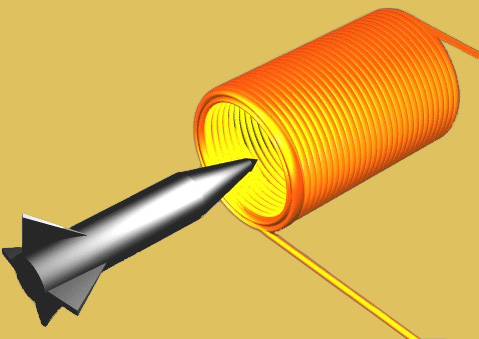
Practical Coilgun Design
How to Measure Speed
Measuring Coilgun Speed
How do you measure the speed of a projectile? Is it difficult or expensive or tricky?
There are several possible (and quite practical) ways to measure the starting speed. This web page describes a way to find the speed that requires no special equipment.
Ways To Measure Speed
Here is a brief overview of various ways to measure speed. Although I used a horizontal ballistic speed trap, some of these would likely work better.
- Stop frame action recording - place a meter stick at the end of the barrel and video tape a shot. Then replay the video and advance it frame by frame and measure how far the projectile traveled between time stamps.
- Acoustic recording - place a microphone by the end of the firing barrel. Use the sound card on your computer to record a shot. Then edit the recording and use the time scale on the audio software to measure the time between firing and impact. Be sure to compensate for the time delay due to the speed of sound in air.
- Optical speed trap - build two optosensors into the end of the firing barrel. Use a digital timing circuit to measure the elapsed time between the sensors.
- Horizontal ballistic speed trap (below) - place a box of dividers at some distance out and down from the coilgun. Measure the horizontal and vertical distance for each shot. This is good for lower speed coilguns.
- Vertical ballistic speed trap - place a vertical sheet of styrofoam or cardboard some distance away. Measure the horizontal and vertical distance to where the projectile is captured. This is good for higher speed coilguns.
- Ballistic pendulum (below) - capture the projectile in a swing, and measure the height to which it rises.
Ballistic Pendulum
The "how fast does it go" question can be answered by using a ballistic pendulum. It consists of a capture box of known mass suspended from some light wires. You fire the projectile into the box and measure the height that it rises. You can compute the speed if you also know the mass of the projectile and the mass of the pendulum.
You can also read a complete description of building a ballistic pendulum from the book "Backyard Ballistics" by William Gurstelle, Chicago Review Press, ©2001, ISBN 1-55652-375-0.
The general idea is that the coilgun (or cannon or slingshot or whatever) will be shot point-blank into the pendulum's box. The projectile's momentum is transferred to the pendulum and its velocity can be determined from the height to which the whole thing rises.
Suspend your ballistic pendulum from a ledge or ladder. It is important that the box swings freely after capturing the projectile. As it swings, a marker pen will trace out the path of the box on the paper attached nearby, marking the pendulum's highest and lowest points. The difference in height between the apex (top) of the swing and rest position (bottom) allows us to determine the total momentum, and therefore the projectile's speed.
Speed = (1 + M/m) * SQRT(2gh)
Where M is the mass of the box, and m is the projectile's mass. Also, g is gravity and h is the total rise in height. You can use metric (kilograms and meters) or english (feet and pounds), but be consistent!
| < Previous | Page 1 of 9 | Next > |
©1998-2025 Barry Hansen